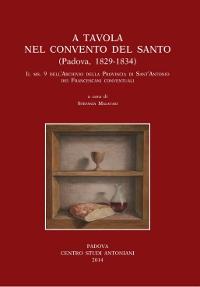A tavola nel Convento del Santo (Padova, 1829-1834) Il ms 9 dell'Archivio della Provincia di Sant' Antonio dei Francescani conventuali
Nota: L'acquisto on-line verrà gestito attraverso il sito LIBRERIA DEL SANTO. Il volume può essere richiesto anche direttamente al Centro Studi Antoniani inviando una email a info@centrostudiantoniani.it
Perché “A tavola nel Convento del Santo”? Perché è lì che ci porta il manoscritto n. 9, compilato da un umile e quasi ignoto cuoco al servizio della comunità. Poco sappiamo di lui: proveniente da un piccolo borgo del Trentino, con qualche difficoltà di scrittura, ma dotato di grande pazienza e di altrettanta buona volontà, egli annota nel suo quaderno cibi e vivande che prepara a pranzo e cena per i frati del convento, e per le altre numerose persone spesso ospiti presso la comunità francescana di Padova. Il cuoco tuttavia non scrive solo di gastronomia, ma anche di eventi e personaggi che attirano la sua attenzione, lasciando così testimonianze di grande interesse per la storia sociale e religiosa di quegli anni, i primi decenni dell’Ottocento.
Riguardo alla descrizione dei menu quotidiani si può dire che il documento è fino ad oggi l’unico riguardante la storia della cucina padovana del periodo, che certamente nel passato aveva conosciuto momenti di grande splendore, legati tuttavia a singole casate o personaggi, ma che nel tempo si era attestata a contenuti più “praticabili”, conseguente frutto di necessità sociali ormai mutate. Il manoscritto ci consegna dunque una cucina fortemente legata al territorio e ai prodotti stagionali, spesso provenienti da proprietà del convento; abbonda il riso, usato quotidianamente insieme alla pasta per le minestre, mentre pesci, uova, formaggi e verdure sono consumati nei giorni di magro. Carni e frattaglie, usate in abbondanza, di frequente sono “riciclate” sotto forma di pasticci o polpette. I dolci, infine, che il cuoco prepara con grande cura, sono riservati alle feste liturgiche o all’arrivo di qualche ospite importante. E al riguardo si può dire che il cuoco registra molte notizie interessanti, ricordando persone e fatti che accadono nella comunità e in città: i religiosi che si distinsero per l’insegnamento nello Studio patavino, quelli che si impegnarono a riportare il convento alla rinnovata armonia dopo le complesse vicende del periodo napoleonico. Non mancano eventi più o meno lieti: celebrazioni legate al culto del Santo, presenza di celebri predicatori, ma anche la paura dell’incipiente epidemia di colera, o i danni che la città subisce per temporali e grandinate eccezionali. Il tutto descritto con garbo e umiltà, e ravvivato da velate “riflessioni” personali che danno al testo gradevole vivacità.
Why “A tavola nel Convento del Santo”? Because it’s ther that brings us manuscript no. 9, written by a humble and almost unknown chef who served his community. Little is known of him: he came from a small village in Trentino, had some difficulties in writing, but whith great patience and as much good will, he took note of all of the foods and beverages he served for lunch and dinner for friars of the convent, and for many other people that often were guests at the Franciscan community of Padua.
The cook does not write only for food, but also of events and characters that attract his attention, ths leaving evidence of great interest to the social and religious history of those years, the first decades of the nineteenth century. With regard to the description of daily menus, it can be said that this is the only known document to date that describes the history of the Paduan cuisine of those days, a cuisine vhich in the past had certainly known moments of great splendor, but it was more related to individual families or characters, and that evolved to a more user-friendly content, following the changing social needs. The manuscript gives us a picture of a cuisine strongly linked to the territory and seasonal production, often coming directly from the properties of the convent; lots of rice, used on a daily basis together with pasta for soups, and fish, eggs, cheese and vegetables are consumed in the “lean” days.
Meat and offal were used in abundance, and frequently were recycled in the form of pies or patties. The desserts, finally, prepared by our cook with great care, are reserved for liturgical feasts or in case some important guest was visiting the convent. And during these occasions the cook recorded many interesting news, keeping track of people and events that happened in the community and in the city: the religious men who distinguished themselves for their teachings in the University of Padua, or those who committed themselves to return the convent to harmony after the complex events of the Napoleon period. Many other more or less pleasing events are recorded: the celebrations connected with cult of the Saint, the presence of famous preachers, but also the fear of incipient outbreak of cholera, or the damages suffered by the city because of exceptional thunderstorms and hailstorms. Everything is described with grace and humility, and enlivened by veiled personal “reflections” that give this text a pleasant liveliness.
Archivum Franciscanum Historicum 107 (2014), 3-4
Padova e il suo territorio 178 (2015)


